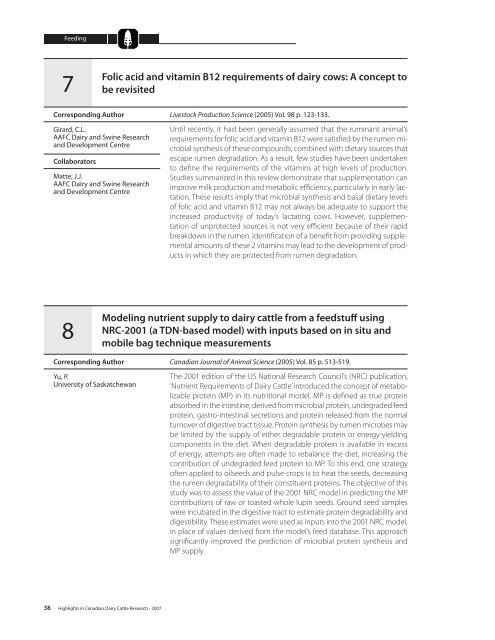Feeding7Folic acid and vitamin B12 requirements of dairy cows: A concept tobe revisitedCorresponding AuthorGirard, C.L.AAFC Dairy and Swine Researchand Development CentreCollaboratorsMatte, J.J.AAFC Dairy and Swine Researchand Development CentreLivestock Production Science (2005) Vol. 98 p. 123-133.Until recently, it had been generally assumed that the ruminant animal’srequirements for folic acid and vitamin B12 were satisfied by the rumen microbialsynthesis of these compounds, combined with dietary sources thatescape rumen degradation. As a result, few studies have been undertakento define the requirements of the vitamins at high levels of production.Studies summarized in this review demonstrate that supplementation canimprove milk production and metabolic efficiency, particularly in early lactation.These results imply that microbial synthesis and basal dietary levelsof folic acid and vitamin B12 may not always be adequate to support theincreased productivity of today’s lactating cows. However, supplementationof unprotected sources is not very efficient because of their rapidbreakdown in the rumen. Identification of a benefit from providing supplementalamounts of these 2 vitamins may lead to the development of productsin which they are protected from rumen degradation.8Modeling nutrient supply to dairy cattle from a feedstuff usingNRC-2001 (a TDN-based model) with inputs based on in situ andmobile bag technique measurementsCorresponding AuthorYu, P.University of SaskatchewanCanadian Journal of Animal Science (2005) Vol. 85 p. 513-519.The 2001 edition of the US National Research Council’s (NRC) publication,‘Nutrient Requirements of Dairy Cattle’ introduced the concept of metabolizableprotein (MP) in its nutritional model. MP is defined as true proteinabsorbed in the intestine, derived from microbial protein, undegraded feedprotein, gastro-intestinal secretions and protein released from the normalturnover of digestive tract tissue. Protein synthesis by rumen microbes maybe limited by the supply of either degradable protein or energy-yieldingcomponents in the diet. When degradable protein is available in excessof energy, attempts are often made to rebalance the diet, increasing thecontribution of undegraded feed protein to MP. To this end, one strategyoften applied to oilseeds and pulse crops is to heat the seeds, decreasingthe rumen degradability of their constituent proteins. The objective of thisstudy was to assess the value of the 2001 NRC model in predicting the MPcontributions of raw or toasted whole lupin seeds. Ground seed sampleswere incubated in the digestive tract to estimate protein degradability anddigestibility. These estimates were used as inputs into the 2001 NRC model,in place of values derived from the model’s feed database. This approachsignificantly improved the prediction of microbial protein synthesis andMP supply.38 Highlights in Canadian Dairy Cattle Research - 2007
Feeding9Dietary forage and nonfiber carbohydrate contents influenceb-vitamin intake, duodenal flow, and apparent ruminal synthesis inlactating dairy cowsCorresponding AuthorShaver, R.D.University of WisconsinCollaboratorsSchwab, E.C.University of WisconsinSchwab, C.G.University of New HampshireGirard, C.L.AAFC Dairy and Swine Researchand Development CentrePutnam, D.E.Balchem CorporationWhitehouse, N.L.University of New HampshireJournal of Dairy Science (2006) Vol. 89 p. 174-187.Until recently, it had been assumed that basal dietary supply plus rumenmicrobial synthesis were sufficient to satisfy the B-vitamin requirements ofruminant livestock. However, studies have demonstrated that supplementationof the B-vitamins thiamine, biotin, niacin and folic acid to lactatingdairy cows could improve production. In contrast, other studies failed toshow such responses when similar amounts of these vitamins were addedto diets. Possible reasons for these inconsistent results are many but onepossibility is that the varying diets fed in these trials influenced the synthesisof vitamins by rumen micro-organisms. The objective of this studywas to examine this possibility by estimating microbial B-vitamin synthesisin cows fed diets containing varying proportions of forage and non-fibrecarbohydrates (NFC). Holstein cows fitted with ruminal and duodenal cannulaewere offered each of 4 different total mixed rations (TMRs) duringsequential 21 day periods. TMRs contained 35 or 60% forage and 30 or 40%NFC. No supplemental B-vitamins were fed. Rumen synthesis of pyridoxine,folic acid and B12 was lower when cows were fed the higher foragediets. Higher dietary NFC levels increased the synthesis of nicotinic acid,nicotinamide, niacin, pyridoxine, B6 and folic acid by decreased B12. Theseresults support the hypothesis that rumen microbial B-vitamin synthesis isinfluenced by diet.10Effects of physically effective fiber on chewing activity and ruminalpH of dairy cows fed diets based on barley silageCorresponding AuthorBeauchemin, K.A.AAFC Lethbridge Research CentreCollaboratorYang, W.Z.AAFC Lethbridge Research CentreJournal of Dairy Science (2006) Vol. 89 p. 217-228.The high grain diets typically fed to dairy cows in early lactation often producesubacute ruminal acidosis (SARA), characterized by depressed rumenpH. Ideally, the acids produced by the fermentation of carbohydrates areneutralized by salivary buffers or absorbed through the rumen wall. SARAresults when the rate of acid production exceeds the rate of absorptionand/or the buffer supply. Physically effective (pe) fibre provokes chewingwhich stimulates saliva production so the question becomes: What is theoptimal dietary balance between fermentable carbohydrates and pe fibrewhich will maximize production and minimze the incidence of SARA?The objective of this study was to determine this optimal balance for dietsbased on barley silage and barley grain. Cows were sequentially offered 3diets containing barley silage chopped long, medium or fine with physicallyeffective neutral detergent fibre (peNDF) levels of 13.8, 11.8 and 10.5%,respectively. Total chewing time increased in proportion to dietary peNDFbut measures of rumen pH status were not affected by peNDF. These resultssuggest that increased chewing and subsequent saliva productionwere not sufficient to fully overcome the rumen pH lowering effect of thehigh concentrations of acids produced through fermentation of dietarycarbohydrates.Feeding 39





